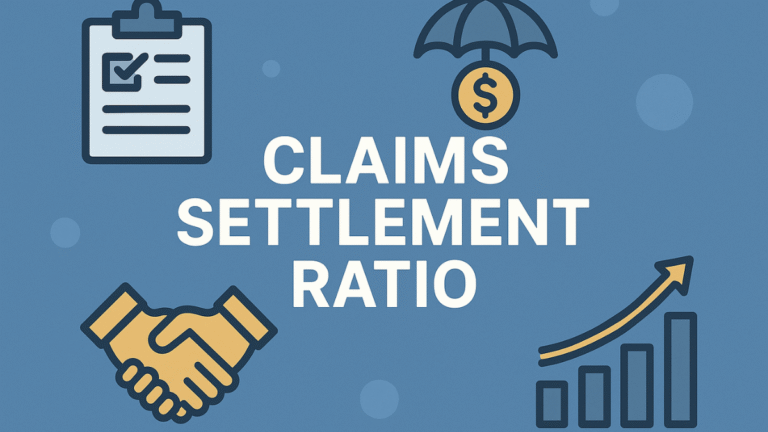When you’re purchasing an insurance policy—be it life, health, or motor—one of the most crucial factors to consider is the Claims Settlement Ratio (CSR) of the insurance company. While features like premiums, policy coverage, and add-ons often get the spotlight, it’s the CSR that ultimately reflects how dependable the insurer is when you need them the most.
In this article, we’ll explore everything you need to know about the Claims Settlement Ratio, its importance, how it’s calculated, and how it should influence your choice of insurer.
What is Claims Settlement Ratio?
The Claims Settlement Ratio is a metric used to evaluate how efficiently an insurance company settles the claims made by policyholders.
Definition
The Claims Settlement Ratio is the percentage of insurance claims settled by an insurance company out of the total number of claims received during a financial year.
Formula
Claims Settlement Ratio (CSR)=(Total Claims SettledTotal Claims Received)×100\text{Claims Settlement Ratio (CSR)} = \left( \frac{\text{Total Claims Settled}}{\text{Total Claims Received}} \right) \times 100Claims Settlement Ratio (CSR)=(Total Claims ReceivedTotal Claims Settled)×100
For example, if an insurer received 10,000 claims in a year and settled 9,700 of them, their CSR would be: (970010000)×100=97%\left( \frac{9700}{10000} \right) \times 100 = 97\%(100009700)×100=97%
Why Claims Settlement Ratio Matters
A high CSR is often seen as a symbol of reliability and trustworthiness. It indicates that the company is likely to settle your claim promptly in case of an unfortunate event.
Real-World Impact
Imagine a grieving family waiting for a life insurance payout or someone urgently needing hospitalization funds. The last thing they want is an insurer that drags its feet or rejects claims without proper reasons.
Trust & Reputation
A consistently high CSR shows that the insurer honors its promises. It builds trust and forms a strong reputation in the market.
Claims Settlement Ratio in Life vs Health Insurance
Different types of insurance policies come with different implications for CSR.
In Life Insurance

- A CSR above 95% is considered excellent.
- It provides assurance that your nominee will receive the death benefit without hassle.
In Health Insurance
- A good CSR typically ranges from 85% to 95%.
- Instant claim settlement during hospitalization is vital, especially in emergencies.
What is a Good Claims Settlement Ratio?
There is no fixed benchmark, but industry standards suggest:
| CSR Range | Performance |
|---|---|
| 95–100% | Excellent |
| 90–95% | Good |
| 80–90% | Average |
| Below 80% | Poor |
Always aim to choose a provider with a CSR of at least 90% or more.
How is CSR Different From Claim Rejection Ratio?
While CSR focuses on the settled claims, the Claim Rejection Ratio indicates the number of rejected claims.
Key Differences
| Metric | Measures |
|---|---|
| Claims Settlement Ratio | Claims approved and paid |
| Claim Rejection Ratio | Claims rejected or denied |
| Goal | Higher is better |
| Goal for Rejection | Lower is better (ideally under 5%) |
What Factors Affect Claims Settlement Ratio?
CSR can be impacted by several internal and external variables.
1. Documentation
Incomplete or incorrect documents during the claim process often lead to rejections.
2. Misrepresentation of Facts
Providing false information during policy purchase can lead to claim denials.
3. Complexity of Claims
Some claims are more complicated than others, especially when multiple medical reports or investigations are involved.
4. Company Efficiency
How fast and transparent an insurer’s internal process is also influences CSR.
CSR of Top Insurance Companies in India (2024-25)
Here’s a comparison of popular insurers based on their recent CSR:
| Insurer Name | CSR (2023-24) |
|---|---|
| LIC of India | 98.52% |
| HDFC Life Insurance | 99.3% |
| ICICI Prudential | 97.9% |
| Max Life Insurance | 99.34% |
| SBI Life Insurance | 97.8% |
(Note: Always cross-check the latest IRDAI annual report for updated figures.)
How to Check the Claims Settlement Ratio
The Insurance Regulatory and Development Authority of India (IRDAI) publishes CSR data annually.
Steps to Check CSR:
- Visit the official IRDAI website.
- Look for the “Annual Report” section.
- Open the report for the latest financial year.
- Find the CSR section for life and general insurers.
What a High CSR Doesn’t Guarantee
Although a high CSR is a positive indicator, it doesn’t guarantee:
- 100% claim approval for all policyholders
- Faster settlement in emergency cases
- Customer service quality or grievance redressal efficiency
So, CSR should be one of many factors in your decision—not the only one.
Limitations of Claims Settlement Ratio
While useful, CSR can sometimes be misleading if not interpreted in the correct context.
1. Volume of Claims
A high CSR might be based on a small number of claims, which doesn’t give the full picture.
2. Type of Claims
Some companies settle small-value claims faster while delaying or rejecting higher-value ones.
3. Time Taken to Settle
CSR does not reflect how fast claims are settled—only that they were eventually settled.
Claim Settlement Ratio vs Incurred Claim Ratio
These are two separate metrics often confused:
| Metric | Meaning |
|---|---|
| Claims Settlement Ratio | Claims paid vs. claims received |
| Incurred Claim Ratio | Claims paid vs. total premiums collected |
Incurred Claim Ratio is more relevant in health insurance, indicating profitability and pricing practices.
How CSR Helps You Choose the Right Insurer
A good CSR:
- Builds consumer confidence
- Reduces the risk of claim rejection
- Ensures better peace of mind
If two insurers offer similar policies at similar prices, go for the one with the higher CSR.
Things to Consider Along With CSR
Don’t rely on CSR alone. Also look at:
1. Claim Turnaround Time
How long the insurer takes to settle the claim.
2. Network Hospitals or Garages
Especially relevant for health and motor insurance.
3. Customer Reviews

Check online testimonials and complaint records.
4. Grievance Redressal Record
Some insurers may settle claims, but only after multiple escalations.
CSR Trends During COVID-19
During the pandemic years (2020–2022):
- Many insurers saw lower CSRs due to a surge in death and health claims.
- However, reputed insurers maintained 90%+ ratios even under pressure.
This reflects the true capability of an insurer during crisis periods.
Tips to Ensure Your Claim Isn’t Rejected
To avoid becoming part of the rejected-claims statistic:
- Disclose everything honestly during application.
- Keep documentation ready and updated.
- Inform nominees/family about the policy.
- Understand exclusions and inclusions in the policy wording.
- Pay premiums on time to avoid lapses.
Also Read: The Beginner’s Guide To Online Insurance Quote
Conclusion
The Claims Settlement Ratio is one of the most critical benchmarks to judge the credibility and reliability of an insurance provider. It serves as a simple yet powerful metric that shows how committed an insurer is to supporting its policyholders during difficult times. However, while a high CSR is a good sign, it must be evaluated in context along with other factors like customer service, turnaround time, and policy terms.
When it comes to protecting your life, health, or assets, every detail counts—and knowing an insurer’s CSR can make a significant difference when it matters most.
FAQs
1. What is considered a good claims settlement ratio?
A CSR above 95% is considered excellent. Always aim for companies with CSR above 90%.
2. Does a high CSR guarantee my claim will be settled?
Not necessarily. While it increases the likelihood, each claim is still evaluated based on its individual merits and documentation.
3. Where can I find an insurer’s CSR?
You can find it in the IRDAI’s annual report on their official website or through reputed financial portals.
4. Is CSR the only thing I should consider?
No. You should also consider customer reviews, claim turnaround time, network coverage, and premium rates.
5. Can CSR vary every year?
Yes, CSR can fluctuate due to the number of claims received, natural disasters, pandemics, and changes in internal company processes.

